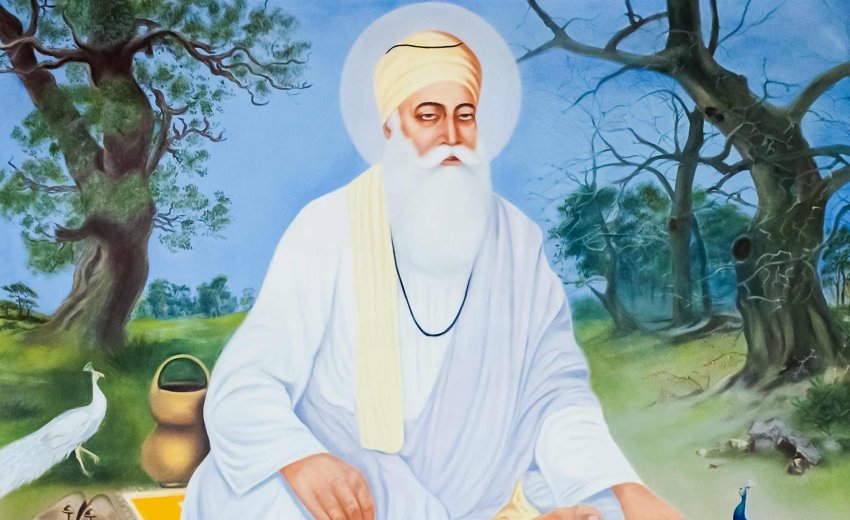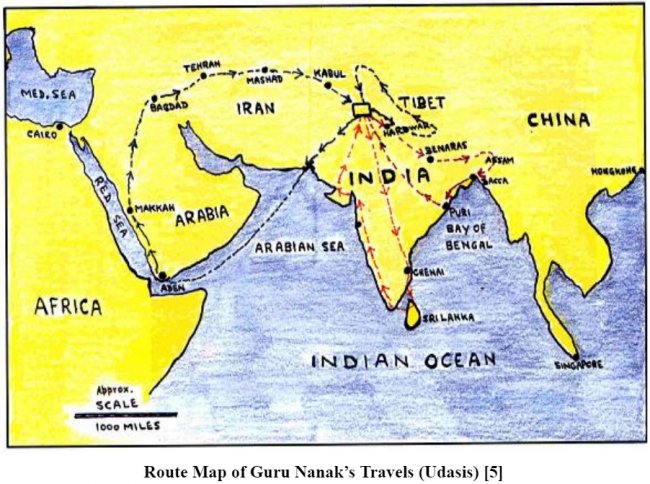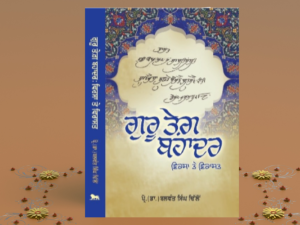Guru Nanak and Martin Luther [1]: Guru Nanak’s life span (1469–1539 CE) corresponds approximately to the German reformer Martin Luther’s (1483–1546). In North India and northern Europe, respectively, each proclaimed religious insights and set in train what have proved to be enduring changes to the institutional profile of religion globally. Both criticized superstition, ritual, and priest craft, and realized the need to communicate religious teaching through the vernacular rather than through an ancient sacred language. But both reformers belonged to different social and cultural milieus.
Whereas Martin Luther’s Germany was Roman Catholic, owing allegiance to the Pope in Rome, Guru Nanak’s Punjab was spiritually and culturally more diverse, and its largely Hindu population was subject to Muslim overlords. In fact, another useful chronological comparison is that between the lifetimes of the Sikh Gurus (1469–1708) and the reigns of the Mughal emperors of North India from Babur, who ruled North India from 1526, until Aurangzeb, who died in 1707 (just one year before the death of Guru Gobind Singh). The Gurus’ lives were directly affected by the actions of their Muslim rulers.
Guru Nanak: Early Life & Education [2, 3]
Guru Nanak was born on April 15, 1469, at Rai Bhoi Ki Talwandi (present day Nankana Sahib, now in Pakistan). He was born to Mehta Kalyan Chand and Mata Tripta in a Hindu Bedi family. His father was a revenue official (patwari) working on the estate of Rai Bular Bhatti in village Talwandi. He was a precocious child who would spend most of his time in meditation. According to Sikh traditions, the birth and early years of Nanak's life were marked with many events that demonstrated that Nanak had been blessed with divine grace. Commentaries on his life give details of his blossoming awareness from a young age. For instance, at the age of five, Nanak is said to have voiced interest in divine subjects. At age seven, his father enrolled him at the village school. He was tutored by a Pundit and Maulvi both in Sanskrit and Persian, respectively. He challenged his teachers to teach him the meanings of Alphabets. When they failed, he recited to explain the alphabets, known as Patti (Tablet) in the holy scripture of Sikh religion, known as Sri Guru Granth Sahib (SGGS).
Guru Nanak revolted against the established religious practices at a very young age. At the age of nine, the family called the Purohit (family priest) to initiate Nanak into Hindu Dharma through Janeau ceremony, where it becomes obligatory to wear a cotton thread over the body of an initiate. It was held as a social custom and all relatives and village community was invited to participate. The young Nanak refused to wear the Sacred thread which was an affront to the family and the Hindu clergy called to perform the ritual. Nanak surprised everyone present by his logical reasoning, “What is the use of wearing this cotton thread if it is not made of mercy, contentment, continence and truth, and will not last till the end”.
Guru Nanak Moves to Sultanpur Lodhi [4]: Parents of Nanak were worried about his future as he was not interested in mundane realities of life. Nanak’s elder sister Bebe Nanaki was married to Jai Ram, who was employed at a modikhana (a storehouse for revenues collected in non-cash form) in the service of the Nawab Daulat Khan Lodhi. Nanak moved to Sultanpur and started working at the modikhana around the age of 16. Nanak married Sulakhani, daughter of Mūl Chand Khatri on 24 September 1487 in the town of Batala. Nanak lived in Sultanpur in the service of Nawab and earned a reputation for good management and honesty. It was during his stay in Sultanpur that Nanak got enlightenment after a holy dip in river Bein. He disappeared for three days and after he returned, he started exclaiming: “There is no Hindu, there is no Musalman”. Guru Nanak achieved his state of enlightenment, or realization, sometime around the age of 30.
There were complaints against Nanak that he was condemning religion. He was called in the presence of Nawab to explain his conduct. He was ordered to recite namaz, the Muslim prayer in the mosque. Guru Nanak joined but did not recite as the others were doing. He established the hypocrisy of both Nawab and the Qazi. He resigned his job in the modikhana and prepared himself for preaching his mission in India and other countries of Asia. For this purpose, he left his family behind in the care of his sister, Nanaki. He took a Muslim of Talwandi, Bhai Mardana, as a ministrel to accompany him during his preaching journey.
Guru Nanak's Journeys (Four Udasis) [5, 6]:
- During his first journey (1499-1507): Guru Nanak covered most parts of present day India and Pakistan.
- Second journey (1507-1514): Guru Nanak visited most parts of South India and present day Sri Lanka.
- Third journey (1514-1518): Guru Nanak travelled to the North passing through places like Kashmir, Nepal, Sumer Parbat, Tibet and Sikkim in the Himalayas.
- Fourth Journey (1519-1521): He travelled to the West, visiting places like Mecca, Baghdad and most parts of the Middle East.
- He was accompanied by Bhai Mardana (a Muslim) in most of his journeys. It is believed that Guru Nanak spent 24 years of his life in his journeys, covering a distance of 24,000 kms. on foot.
- After his four Udassis, Guru Nanak founded a township of Kartarpur on the bank of river Ravi and focused on spreading his message within and outside of Punjab.
Route Map of Guru Nanak’s Travels (Udasis) [5]
Guru Nanak and his Teachings [7, 8]
Guru Nanak rejected the notion of divisions between people based on religion. He taught the Oneness of the Creator and the fundamental brotherhood and sisterhood of all. He stated that the experience of the Divine dwelled within every person, so there was no difference between people based on caste, creed, gender or nationality. His simple but profound philosophy rested on recognizing the fundamental Divinity of all people. When lived in an awareness of the Divine Light within all, human life could become a profound experience of love, truth, patience, peace and contentment.
- In Guru Nanak’s worldview, there is no dichotomy in spiritual and empirical life.
- He condemned slavery, caste system and preached equality of all mankind.
- Guru Nanak contributed to women empowerment and non-discrimination in India.
- Guru Nanak rejected asceticism and supported the lifestyle of a householder.
- He taught his followers the methods to attain salvation without recourse to any priests, dogmas, rituals and superstitions.
- Guru Nanak always stressed the inner spiritual awakening through Meditation on the Naam (Ultimate Reality).
- Guru Nanak preached a scientific vision of creation of Universe compatible with Big Bang hypothesis.
Guru Nanak’s World View: In Guru Nanak’s world view, both spiritual and empirical modes of life are inter-dependent. According to the Guru, this world is not only real but it is the place where God’s creative and attributive Will (Hukam) works. The methodology and ethics for the spiritual path of man is laid down in this world. God is involved in the world as sustainer and nourisher of life. The world being a creation of God, and God being the ocean of virtues, moral life is in line with the attributive Will of God. In Sikh religion, there is no dichotomy between spiritual and empirical life. Salvation is the privilege of man involved in worldly pursuits of life.
Guru Nanak’s Ode to Womanhood: Guru Nanak gave religious sanctity to married life and put woman on a high pedestal in society. In all religious traditions of India, woman was treated as second rate or equal in social status to Shudras in Hindu religion. In Raag Asa, Guru Nanak sang paeans in praise of woman [9]:
From woman, man is born; within woman, man is conceived; to woman he is engaged and married. Woman becomes his friend; through woman, the future generations come. When his woman dies, he seeks another woman; to woman he is bound. So why call her bad? From her, kings are born. From woman, woman is born; without woman, there would be no one at all. O Nanak, only the True Lord is without a woman.
Guru Nanak Rejected the Caste System of Hindu Society [10]: His compositions stand witness to his attitude towards caste system. Guru Nanak emphatically said: “God does not care for our caste or birth”. Guru Nanak advised rather urged the people to discard caste and have faith on the Almighty [11-14]:
Preposterous is caste and vain the glory.
The Lord alone gives shade to all the beings.
Each one of you should see the light within and
do not ask his caste as caste is of no use hereafter.
What merit does caste possess?
Search for the truth within.
Guru Nanak emphatically said:
God does not care for our caste or birth.
Hence one should look for the house of truth
for as one's deeds be, so be one's caste.
Guru Nanak Rejected the Rituals and Superstitions of Society: Guru Nanak wanted to liberate the contemporary social order of false rituals, futile religious ceremonies and asceticism. Superstitions were denounced by him. Other customs like those of homas yag, worshipping of tombs and places of cremation and undergoing fasts were regarded futile and devoid of virtue. He recommended the praise of Almighty and good deeds for liberation of the soul.
Guru Nanak Condemned the Political Tyranny and Misrule [10]: The contemporary political system implied corruption, political cruelty and tyranny. He showed resentment while noticing the political disorder in the country. A number of references are found in the compositions of Guru Nanak with regard to political misrule. Guru Nanak argues [15]:
If clothes be sustained with blood the garments get polluted.
Who suck the blood of human beings,
How can their mind be pure?
Guru Nanak's comments about the political tyranny exist in the Guru Granth Sahib [16]:
The kali age is a knife, the kings are butchers,
Dharma is on the wings and is disappearing,
The moon of truth does not appear to rise in the dark night of falsehood.
Guru Nanak shows his discontent and uneasiness over the deterioration and corruption of the rulers [17]:
The raja administers justice only if his palm is greased;
In the name of God none is moved.
Guru Nanak Promoted Life of a Householder [10]: Guru Nanak rejected incarnation theory of Hinduism and discarded celibacy as a way of life. He was in favour of leading a householder’s life as it encourages and leads to all round development and social progress. He preferred to give gurgaddi to a householder devotee, Bhai Lehna, instead of his own son, Sri Chand, who displayed the signs of asceticism.
Guru Nanak’s Philosophy of Truth and Naam: Guru Nanak advocates the primacy of truthful living in the society [18]:
How can we be true and how can the screen of untruth be rent?
By obeying, O Nanak! the pre-ordained order of the Lord of will.
There is a famous saying of Guru Nanak [19]: “Truth is high, but higher still is truthful living.” By this he means that living truthfully, showing devotion to truth through one's behavior and actions, brings one closer to spiritual awakening and to God. Righteousness and morality are central to the practice of Sikhism.
According to Guru Nanak, the Naam encompasses the whole of creation—everything outside the believer and everything within him. One has to become imbued with ‘Naam’ to understand the blessings that come with this realization. When one is imbued with ‘Naam’ only then can the person understand the essence of the Lord - Waheguru, Raam, Allah, God, etc. In Sikhism the repeating of Name is regarded as panacea for all the diseases. By repeating the Name of fearless God, one becomes fearless himself. The repeating of Name means vanishing of the fear of horrified death. It helps in achieving the mission of life and attainment of spiritual power etc.
Naam, stands for the union of the mind and spirit with Reality, which is to be attained by the devoted repetition of his Name both verbally and "mentally". It is the key to enter into the presence and the heart of God. Naam brings in peace and tranquility, and a calmness that otherwise can never be experienced. God's greatness is beyond human comprehension. But He can be approached through a ladder called 'Naam'. Naam, therefore, is greater than everything else "sabte ucha jaka nao" and "wada sahib uncha thaon, uche upar ucha nao." According to Guru Nanak, His eternal name is "Sat", i.e. Truth. He is true and so is His Naam - "Sacha sahib, sach nae."
Guru Nanak’s Experiment of Preaching Sikh Way of Life at Kartarpur [20, 21]
Around the age of 55, Nanak settled in Kartarpur, living there until his death in September 1539. Guru Nanak returned to Kartarpur where he put aside his attire of a hermit. He was engaged in farming to earn his livelihood. Putting on a householder’s dress, he sat on a cot and executed his mission. The daily prayers based on the recitation of the compositions of the Guru, followed by the langar, which involved communal cooking and sharing food, served as agencies of internal solidarity as well as distinction from others such as Shaivites, Vaishanavites, Shaktas, Sufis, and Sunnis. Thus, Guru Nanak saved the people from the clutches of tantra, mantra and Atharvaveda.
People from all sections of society respected and loved Guru Nanak because of his liberal philosophy, humane outlook and inclusive ideology. This is reflected in the popular saying of the time: Nanak Shah Fakir, Hindu Ka Guru Musalman Ka Pir!
Guru Nanak appointed Bhai Lehna as the successor Guru, renaming him as Guru Angad, meaning "one's very own" or "part of you". Shortly after proclaiming his successor, Guru Nanak died on 22 September 1539 in Kartarpur, at the age of 70. Guru Nanak's body was never found. When the quarreling Hindus and Muslims tugged at the sheet covering Nanak’s body, they found instead a heap of flowers — and so Nanak’s simple faith would, in course of time, flower into a religion, beset by its own contradictions and customary practices.
Conclusion [22]
Guru Nanak’s teaching was addressed to all men irrespective of caste, race or religion. He attacked empty rituals and ceremonies but never any religious faith. He condemned those Pundits and Mullahs who abused their faith for personal power and pelf. He called upon Hindus to become better Hindus and Muslims to become better Muslims.
Although Guru Nanak tried to reconcile both Hinduism and Islam to bring peace in the Punjab, it would not be right to assume that the faith he founded was a synthesis of these two religions. Guru Nanak propounded many new concepts and revolutionary ideas that became the corner-stone of his new faith and gave it distinct form and unique content. Guru Nanak was seeking to establish an alternative religious order which was far more inclusive and radical in beliefs than the traditional religions inherited by him. It was his innovative genius that he laid the foundation of a faith, based on unity of God, human equality, religious tolerance and deep moral and ethical values, at a time when these human imperatives were conspicuous by their absence.
Guru Nanak tried to bring both the major communities closer to each other by preaching love, equality of all human beings, religious tolerance and mutual respect. The teaching of Guru Nanak is as relevant today as they were five hundred and fifty years ago to bring peace, amity, communal harmony and national integration.
References
-
Hardev Singh Virk. Guru Nanak and Martin Luther: A Comparative Study. Paper Presented at Guru Nanak Dev University Conference, Amritsar.
-
Nikky GK Singh. Sikhism: An Introduction. IB Tauris Co Ltd. London, 2011.
-
Eleanor Nesbitt. A very brief Introduction to SIKHISM. Oxford University Press, 2005.
-
Wikipedia. https://en.wikipedia.org/wiki/Guru_Nanak
-
Sikh Missionary Society, UK. sikhmissionarysociety.org
-
Daljit Kaur. An Apologue Guru Nanak: Globetrotter or a Pioneer. IJARESM, June 2021.
-
Daljit Singh. Essentials of Sikhism. Singh Brothers Amritsar, 1994.
-
Daljit Singh & Kharak Singh. Sikhism: Its Philosophy and History. Institute of Sikh Studies, Chandigarh, 1997.
-
Guru Nanak. Sri Guru Granth Sahib (SGGS), Raag Aassa, P. 473. English Translation, Manmohan Singh. Golden Temple Press, Amritsar.
-
Kavita Rani. Guru Nanak’s Vision and Religious Concepts. Paper presented at Fourth Canadian Punjabi Conference (Celebrating 550th Birth Anniversary of Guru Nanak Dev Ji), Ottawa, Canada, 6 July, 2019, pp. 391-400.
-
Guru Nanak. Ibid. P. 83.
-
Guru Nanak. Ibid. P. 349.
-
Guru Nanak. Ibid. P.142.
-
Guru Nanak. Ibid. P. 1330.
-
Guru Nanak. Ibid. P. 140.
-
Guru Nanak. Ibid. P. 145.
-
Guru Nanak. Ibid. P. 350.
-
Guru Nanak. Ibid. Japu, P.1.
-
Guru Nanak. Ibid. P. 62.
-
Gurinder Singh Mann. Guru Nanak’s Life and Legacy: An Appraisal. Global Institute for Sikh Studies, March 2010.
-
Hardev Singh Virk. My Sentimental Journey from Dera Baba Nanak to Kartarpur
(Pakistan). Sikh Review, Jan. 2020. Vol. 68(1), pp. 73-78.
-
Paropkar Singh Puri. Guru Nanak and the Origin of Sikhism. Sikh Review, Jan. 2020. Vol. 68(1), pp. 41-47.







